Prediction of Soil Moisture Content and Soil Salt Concentration from Hyperspectral Laboratory and Field Data
Abstract
:1. Introduction
2. Materials and Methods
2.1. Soil Preparation
- (1)
- Soils were gathered from three study sites. Two of them are located in the Hetao Irrigation District, Inner Mongolia, China (108.01°E, 41.07°N), while the other one is located in Changzhou, China (119.97°E, 31.81°N).
- (2)
- Sand, silt, and clay proportions of the collected soil samples were quantified using the pipette method [31]. Results exhibited three textures: silty loam (SL, collected in Changzhou), clay and silty clay (C and SC, both were collected in the Hetao Irrigation District).
- (3)
- Salt from these soils were washed out and the soils air dried.
- (4)
- Salts were mixed using MgCl2, CaCl2, Na2CO3, NaHCO3, and Na2SO4 with molar concentration ratios of 11.74:8.54:1.00:15.39:20.83. These represent the average salt constitution in the Hetao Irrigation District.
- (5)
- Salty water solutions were made by mixing salt in certain amounts of water. We added these solutions to the air-dried soil to maintain the initial gravimetric soil moisture close to 0.3. Meanwhile, the nine different salt concentrations (g/g) were controlled to range from 0.1% to 1% (Table 1).
- (6)
- We filled the cylindrical container with soil and aimed (20 cm height and 15 cm diameter) to keep the soil bulk density at 1.4 g/cm3.
- (7)
- Time-series of surface hyperspectral reflectance data were measured while measuring the weight for these containers. Measurements continued until the container weights became constant. In total, there were nine measurements for the silty loam, ten measurements for clay and twelve measurements for silty clay.
2.2. Hyperspectral Measurements
2.2.1. Laboratory Measurements
| Laboratory Samples | ||||||
| Sampling Site | Moisture (g/g) | Salt (g/g) | Soil Texture | |||
| Minimum | Maximum | S.D. | ||||
| Changzhou | 0.040 | 0.250 | 0.058 | 0.1,0.2,0.3,0.4,0.5,0.6,0.7,0.8,1.0 (%) | silty loam (SL) | |
| Inner Mongolia | 0.032 | 0.352 | 0.096 | 0.1,0.2,0.3,0.4,0.5,0.6,0.7,0.8,1.0 (%) | Clay (C ) | |
| Inner Mongolia | 0.053 | 0.364 | 0.095 | 0.1,0.15,0.2,0.3,0.4,0.5,0.6,0.7,0.8,1.0 (%) | silty clay (SC) | |
| Field Samples | ||||||
| Sampling Site | Moisture (g/g) | Salt (g/g) | ||||
| Minimum | Maximum | S.D. | Minimum | Maximum | S.D. | |
| Field | 0.132 | 0.238 | 0.023 | 0.060% | 0.930% | 0.180% |
2.2.2. Field Measurements
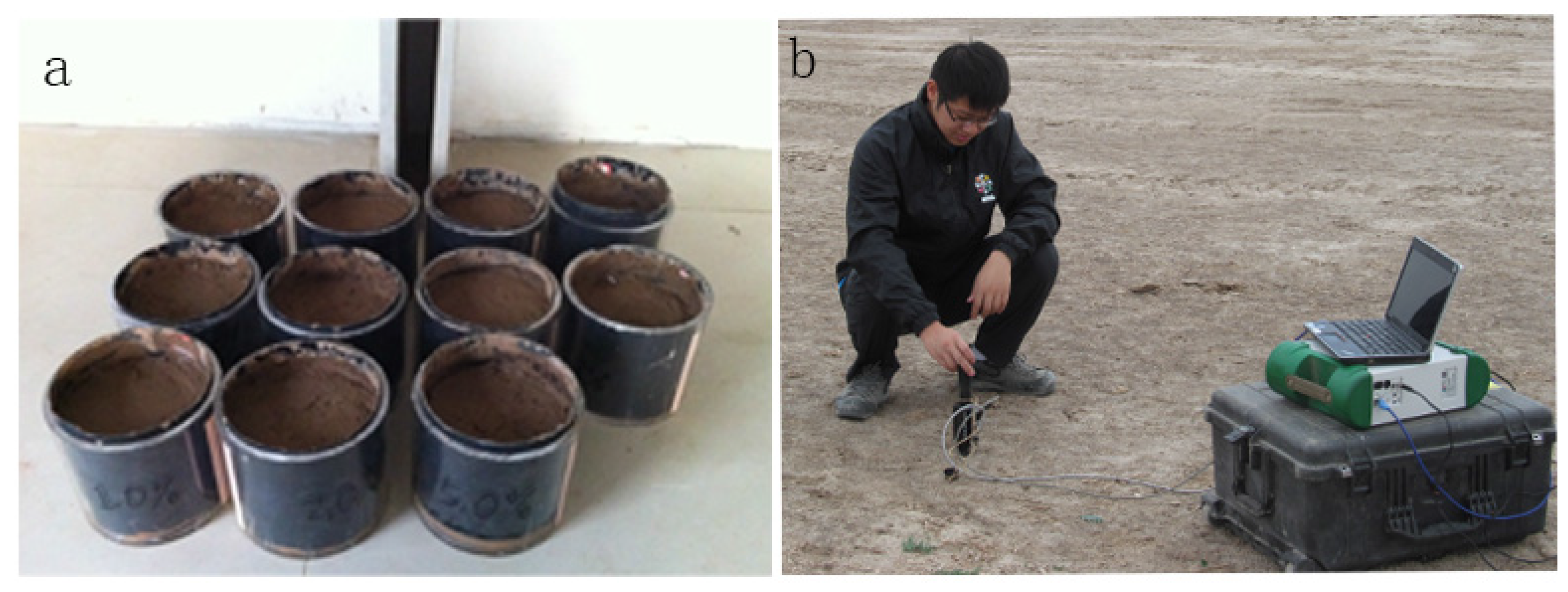
2.3. Spectral Transforms

2.4. Waveband Selection of Sensitive Bands
2.5. Soil Moisture and Salt Model Calibration and Evaluation
| Model Name | Function | Inputs and Outputs |
|---|---|---|
| M_SMC | SMC = f(Rλ, T) | SMC—soil moisture content; SSC—soil salt concentration; Rλ or Nλ or Aλ′ or Aλ″—Spectral Reflectance & Transforms T—exture |
| M_SSC | SSC = f(Rλ, T) | |
| M_SSCSMC | SSC = f(Rλ, SMC) |
2.6. Model Performance Indicators
3. Results and Discussion
3.1. Waveband Selections Sensitive to Soil Moisture and Salt
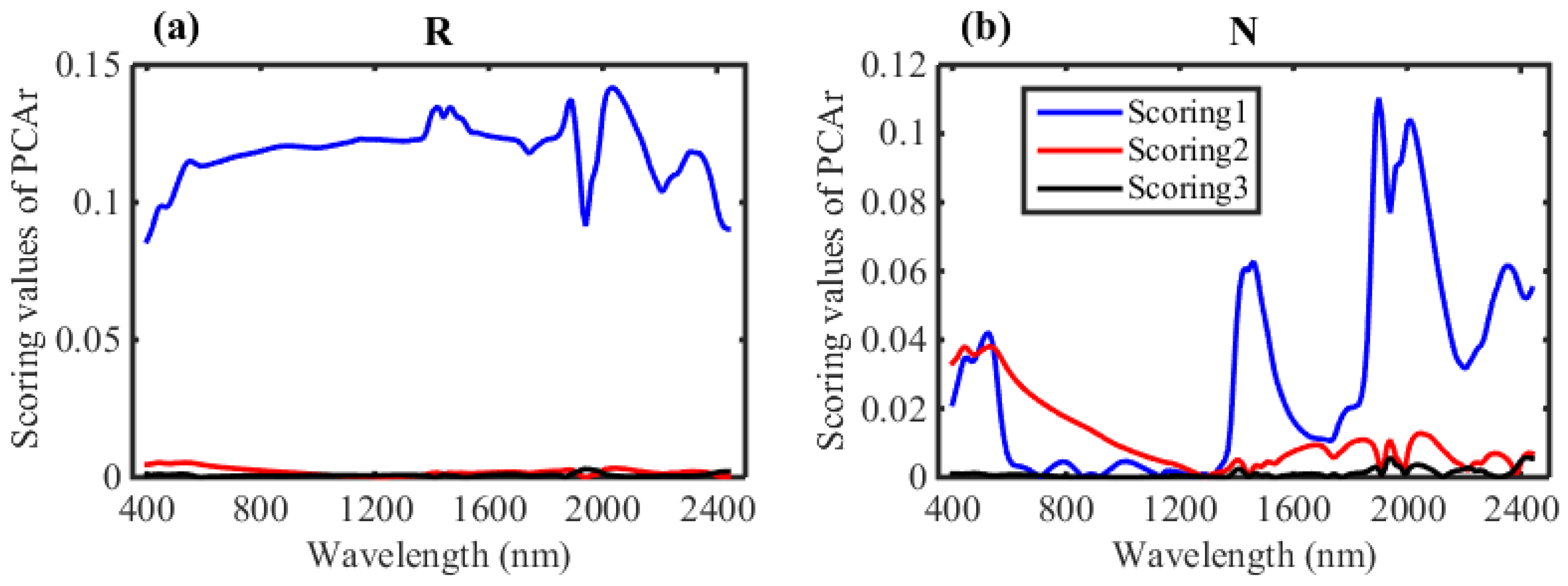
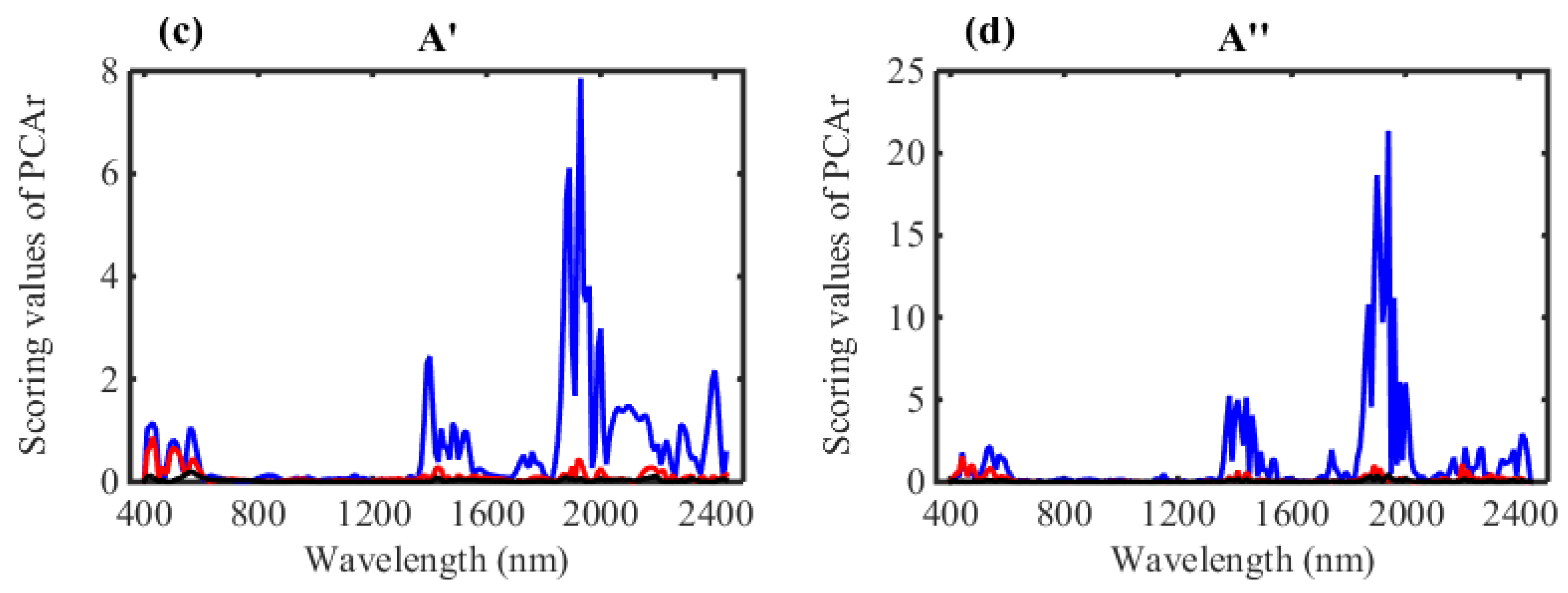
| Zone | Ranges | Selected Wavebands | Physical Mechanism | Active Groups and Wavelength in Soil Spectrum |
|---|---|---|---|---|
| 1 | 400–600 nm | 440 nm, 540 nm, 570 nm | Crystal-field effects | Fe3+, Fe2+, Cr3+, Mn2+ |
| Charge transfer | Fe-O, B-O | |||
| 2 | 1300–1550 nm | 1390 nm, 1430 nm, 1460 nm | Crystal-field effects | Fe2+, Ni2+ |
| Vibrational processes | 2υ(OH-Al), 2υ3+υ2(H2O) | |||
| 2υ(OH-Fe) | ||||
| υ1+2υ3(H2O) | ||||
| 3 | 1690–1800 nm | 1740 nm | Crystal-field effects | Fe2+ |
| Vibrational processes | - | |||
| 4 | 1810–2200 nm | 1870 nm, 1900 nm, 1940 nm, 2010 nm | Crystal-field effects | Fe2+ |
| Vibrational processes | 2υ+δ (OH-P) | |||
| υ1+3υ3 (CO3) | ||||
| υ1+υ3(H2O) | ||||
| 2υ1+3υ3 (CO3) | ||||
| υ1+2υ3 (CO3) | ||||
| 3υ1+2υ1(CO3) | ||||
| υ+2δ (OH-P) | ||||
| 5 | 2200–2450 nm | 2270 nm, 2350 nm, 2410 nm | Crystal-field effects | Fe2+ |
| Vibrational processes | υ+δ (OH-Al) | |||
| υ+δ (OH-Fe) | ||||
| υ3 (CO3) | ||||
| υ+δ (OH-Mg) | ||||
| υ+δ (OH-P) | ||||
| υ(H2O) | ||||
| υ1+2υ3 (CO3) |
3.2. Soil Moisture Characterization
3.2.1. Relationship between Hyperspectral Reflectance and Soil Moisture
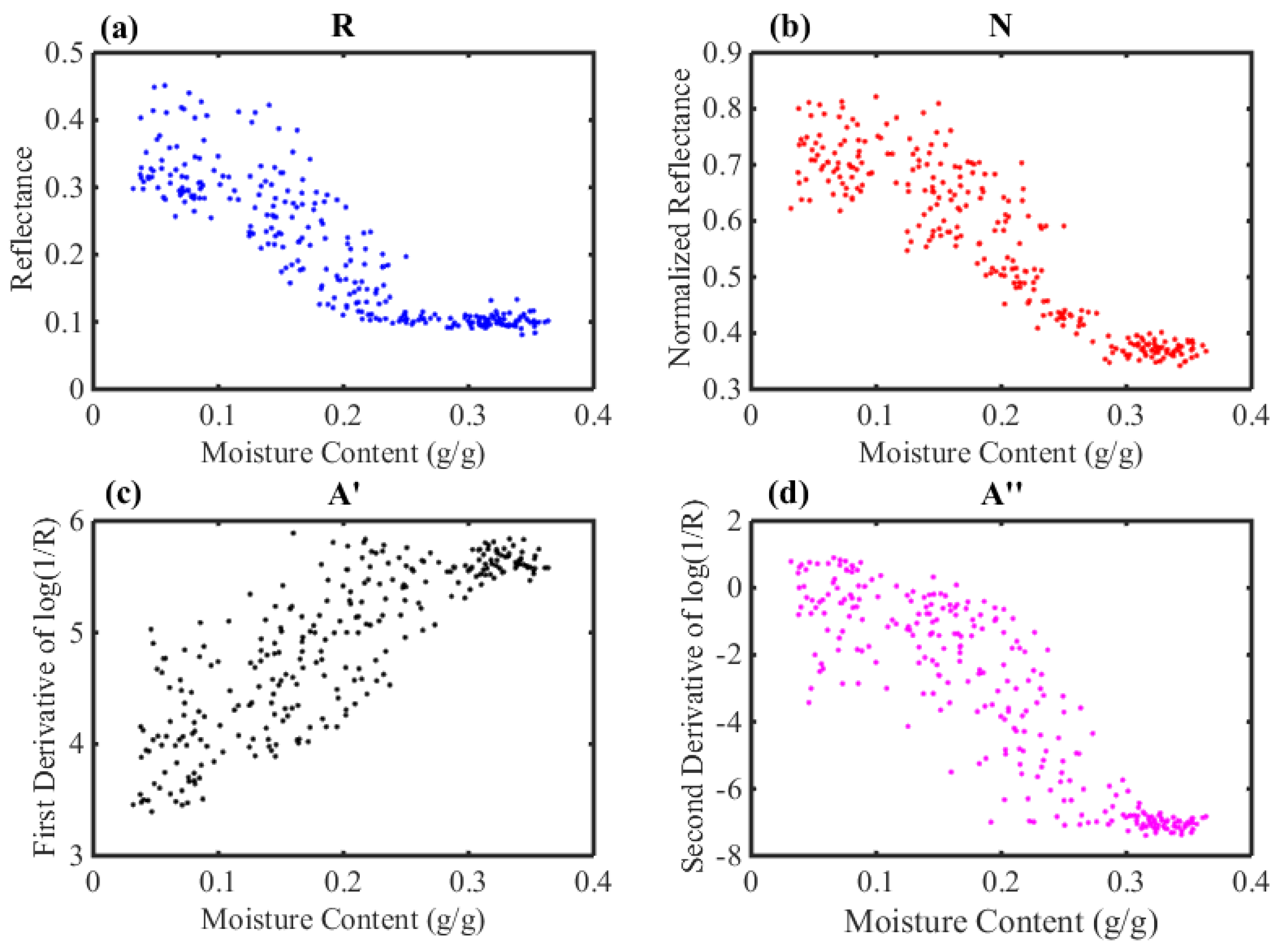
3.2.2. Calibration and Evaluation of M_SMC Models (SMC = f(Rλ, T)) for Soil Moisture Content
| Data set | Lab | Field | ||||
|---|---|---|---|---|---|---|
| SL | C | SC | SL + C + SC | |||
| Number of samples | 41 | 35 | 33 | 109 | 106 | |
| Number of variables | 8 | 2 | 6 | 8 | 4 | |
| Calibration | R2 | 0.933 | 0.973 | 0.979 | 0.937 | 0.529 |
| rRMSE | 0.115 | 0.079 | 0.061 | 0.115 | 0.085 | |
| ME | 0.000 | 0.000 | 0.000 | 0.000 | 0.000 | |
| Evaluation | R2 | 0.758 | 0.940 | 0.913 | 0.842 | 0.309 |
| rRMSE | 0.213 | 0.117 | 0.121 | 0.181 | 0.104 | |
| ME | 0.001 | −0.002 | −0.001 | 0.000 | −0.001 | |

3.3. Soil Salt Characterization
3.3.1. Calibration and Evaluation of Soil Salt Concentration Models (SSC = f(Rλ, T))
| Data set | Lab | Field | ||||
|---|---|---|---|---|---|---|
| SL | C | SC | SL + C + SC | |||
| Number of samples | 41 | 35 | 33 | 109 | 106 | |
| Number of variables | 5 | 6 | 5 | 4 | 4 | |
| Calibration | R2 | 0.874 | 0.748 | 0.828 | 0.470 | 0.333 |
| rRMSE | 0.206 | 0.243 | 0.200 | 0.380 | 0.526 | |
| ME | 0.000 | 0.000 | 0.000 | 0.000 | 0.000 | |
| Evaluation | R2 | 0.730 | 0.282 | 0.639 | 0.543 | 0.306 |
| rRMSE | 0.304 | 0.530 | 0.344 | 0.368 | 0.529 | |
| ME | −0.090 | 0.016 | −0.006 | −0.026 | −0.020 | |
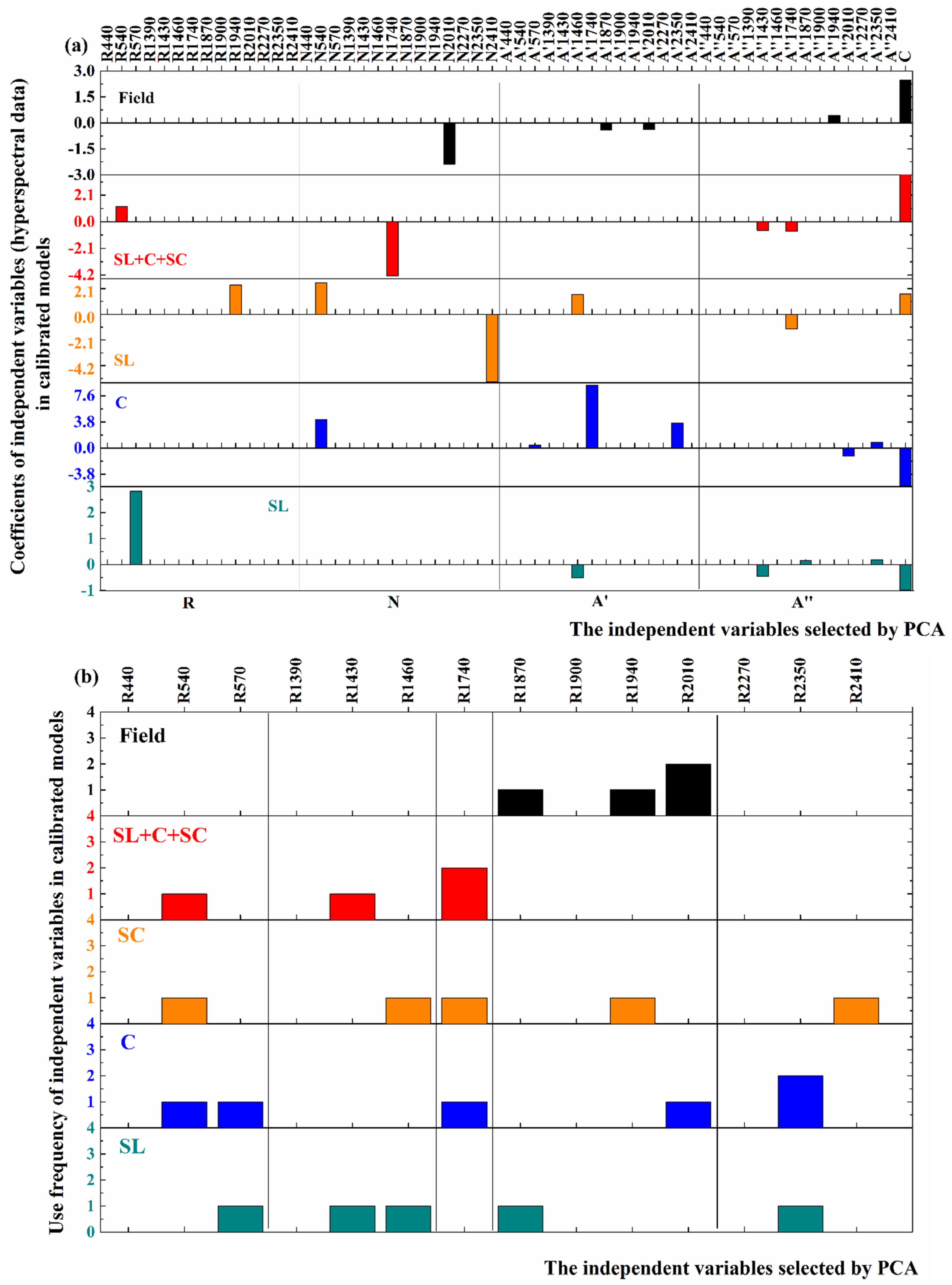
3.3.2. Calibration of M_SSCSMC Models (SSC = f(Rλ, SMC)) for Soil Salt Concentration
| SMC Scale | 0–0.05 | 0.05–0.1 | 0.1–0.15 | 0.15–0.2 | 0.2–0.25 | 0.25–0.3 | |
|---|---|---|---|---|---|---|---|
| SL + C + SC | Number of samples | 11 | 44 | 54 | 44 | 44 | 16 |
| Number of variables | 2 | 5 | 7 | 4 | 3 | 5 | |
| R2 | 0.739 | 0.801 | 0.848 | 0.637 | 0.631 | 0.951 | |
| rRMSE | 0.366 | 0.251 | 0.201 | 0.294 | 0.293 | 0.132 | |
| ME | 0.000 | 0.000 | 0.000 | 0.000 | 0.000 | 0.000 | |
| Field | Number of samples | \ | 7 | 163 | 42 | \ | |
| Number of variables | 2 | 6 | 2 | ||||
| R2 | 0.912 | 0.481 | 0.316 | ||||
| rRMSE | 0.175 | 0.479 | 0.451 | ||||
| ME | 0.000 | 0.000 | 0.000 | ||||
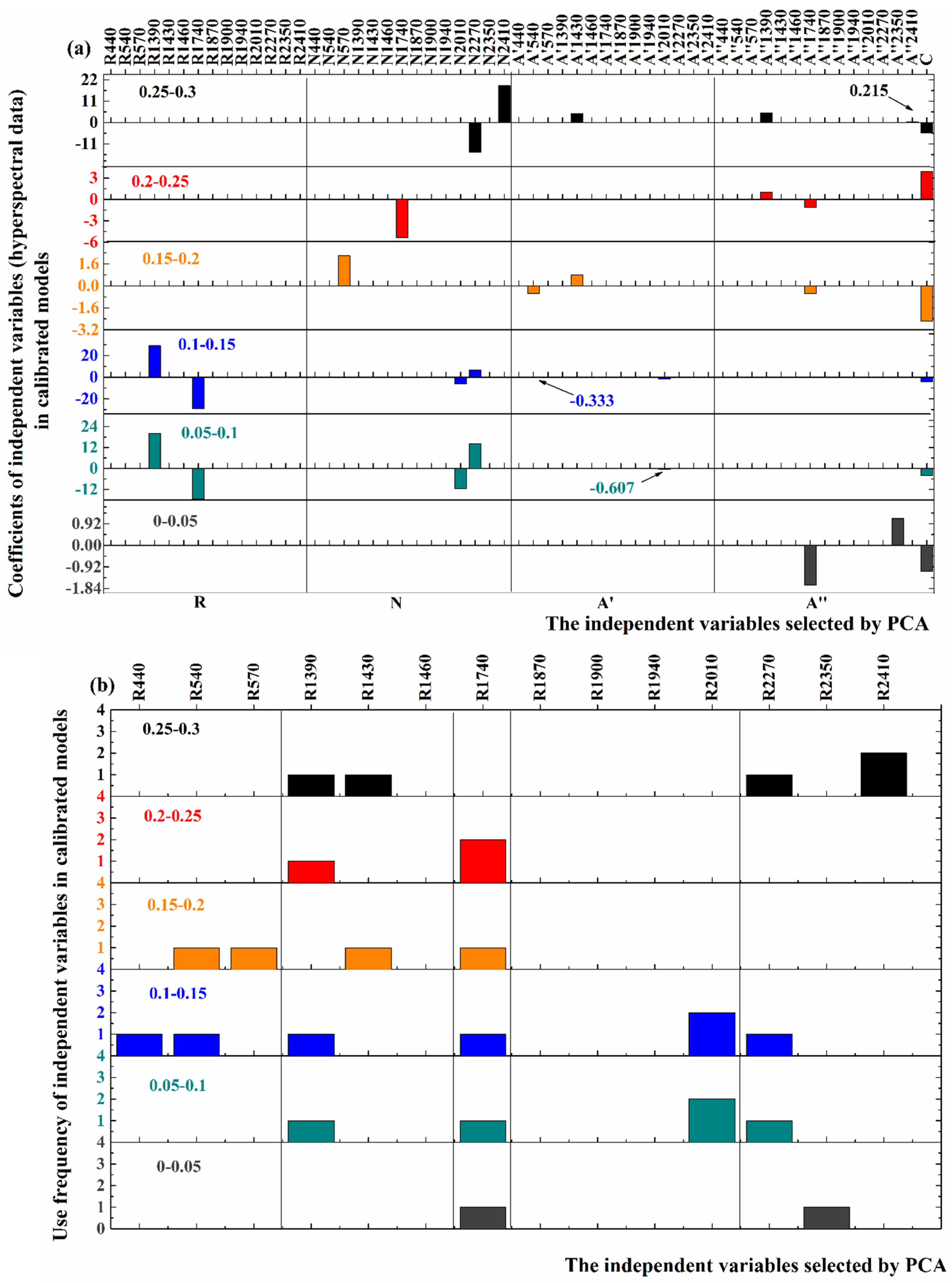

4. Conclusions
Acknowledgments
Author Contributions
Conflicts of Interest
References
- Klute, A. Methods of Soil Analysis. Part 1. Physical and Mineralogical Methods; American Society of Agronomy, Inc.: Madison, WI, USA, 1986. [Google Scholar]
- Rhoades, J. Salinity: Electrical conductivity and total dissolved solids. Methods Soil Anal. Part 1996, 3, 417–435. [Google Scholar]
- Paliwal, K.; Gandhi, A. Effect of salinity, SAR, Ca: Mg Ratio in Irrigation Water, and Soil Texture on the Predictability of Exchangeable Sodium Percentage. Soil Sci. 1976, 122, 85–90. [Google Scholar] [CrossRef]
- Schelde, K.; Thomsen, A.; Hougaard, H. Comparison of EM38 and TDR measurements of soil moisture and electrical conductivity. In Proceedings of the 5th European Conference on Precision Agriculture, Uppsala, Sweden, 9–12 June 2005.
- Seyfried, M.; Grant, L.; Du, E.; Humes, K. Dielectric loss and calibration of the Hydra Probe soil water sensor. Vadose Zone J. 2005, 4, 1070–1079. [Google Scholar] [CrossRef]
- Anderson, M.C.; Norman, J.M.; Mecikalski, J.R.; Otkin, J.A.; Kustas, W.P. A climatological study of evapotranspiration and moisture stress across the continental united states based on thermal remote sensing: 1. Model formulation. J. Geophys. Res.: Atmos. 2007, 112, D10. [Google Scholar] [CrossRef]
- Hain, C.R.; Mecikalski, J.R.; Anderson, M.C. Retrieval of an available water-based soil moisture proxy from thermal infrared remote sensing. Part I: Methodology and validation. J. Hydrometeorol. 2009, 10, 665–683. [Google Scholar] [CrossRef]
- Lane, M. Upcoming Themis investigation of salts on Mars. In Proceedings of the Lunar and Planetary Science Conference, League City, TX, USA, 11–15 March 2002.
- Schmugge, T.; Gloersen, P.; Wilheit, T.; Geiger, F. Remote sensing of soil moisture with microwave radiometers. J. Geophys. Res. 1974, 79, 317–323. [Google Scholar] [CrossRef]
- Mougenot, B.; Pouget, M.; Epema, G.F. Remote sensing of salt affected soils. Remote Sens. Rev. 1993, 7, 241–259. [Google Scholar] [CrossRef]
- Ciani, A.; Goss, K.U.; Schwarzenbach, R.P. Light penetration in soil and particulate minerals. Eur. J. Soil Sci. 2005, 56, 561–574. [Google Scholar] [CrossRef]
- Skidmore, E.L.; Dickerson, J.D.; Schimmelpfennig, H. Evaluating surface-soil water content by measuring reflectance. Soil Sci. Soc. Am. J. 1975, 39, 238–242. [Google Scholar] [CrossRef]
- Ben-Dor, E.; Chabrillat, S.; Demattê, J.A.M.; Taylor, G.R.; Hill, J.; Whiting, M.L.; Sommer, S. Using imaging spectroscopy to study soil properties. Remote Sens. Environ. 2009, 113, S38–S55. [Google Scholar] [CrossRef]
- Van der Meer, F. Analysis of spectral absorption features in hyperspectral imagery. Int. J. Appl. Earth Obs. Geoinf. 2004, 5, 55–68. [Google Scholar] [CrossRef]
- Whiting, M.L.; Li, L.; Ustin, S.L. Predicting water content using gaussian model on soil spectra. Remote Sens. Environ. 2004, 89, 535–552. [Google Scholar] [CrossRef]
- Metternicht, G.I.; Zinck, J.A. Remote sensing of soil salinity: Potentials and constraints. Remote Sens. Environ. 2003, 85, 1–20. [Google Scholar] [CrossRef]
- Csillag, F.; Pásztor, L.; Biehl, L.L. Spectral band selection for the characterization of salinity status of soils. Remote Sens. Environ. 1993, 43, 231–242. [Google Scholar] [CrossRef]
- Cloutis, E. Review article hyperspectral geological remote sensing: Evaluation of analytical techniques. Int. J. Remote Sens. 1996, 17, 2215–2242. [Google Scholar] [CrossRef]
- Hirschfeld, T. Salinity determination using nira. Appl. Spectrosc. 1985, 39, 740–741. [Google Scholar] [CrossRef]
- Wang, Q.; Li, P.; Chen, X. Modeling salinity effects on soil reflectance under various moisture conditions and its inverse application: A laboratory experiment. Geoderma 2012, 170, 103–111. [Google Scholar] [CrossRef]
- Ben-Dor, E.; Patkin, K.; Banin, A.; Karnieli, A. Mapping of several soil properties using DAIS-7915 hyperspectral scanner data—A case study over clayey soils in Israel. Int. J. Remote Sens. 2002, 23, 1043–1062. [Google Scholar] [CrossRef]
- Weng, Y.; Gong, P.; Zhu, Z. Reflectance spectroscopy for the assessment of soil salt content in soils of the yellow river delta of China. Int. J. Remote Sens. 2008, 29, 5511–5531. [Google Scholar] [CrossRef]
- Weng, Y.L.; Gong, P.; Zhu, Z.L. A spectral index for estimating soil salinity in the yellow river delta region of china using eo-1 hyperion data. Pedosphere 2010, 20, 378–388. [Google Scholar] [CrossRef]
- Nawar, S.; Buddenbaum, H.; Hill, J.; Kozak, J. Modeling and mapping of soil salinity with reflectance spectroscopy and landsat data using two quantitative methods (PLSR and MARS). Remote Sens. 2014, 6, 10813–10834. [Google Scholar] [CrossRef]
- Haubrock, S.N.; Chabrillat, S.; Kuhnert, M.; Hostert, P.; Kaufmann, H. Surface soil moisture quantification and validation based on hyperspectral data and field measurements. J. Appl. Remote Sens. 2008, 2, 023552. [Google Scholar] [CrossRef]
- Oltra-Carrió, R.; Baup, F.; Fabre, S.; Fieuzal, R.; Briottet, X. Improvement of soil moisture retrieval from hyperspectral vnir-swir data using clay content information: From laboratory to field experiments. Remote Sens. 2015, 7, 3184–3205. [Google Scholar] [CrossRef]
- Farifteh, J.; Farshad, A.; George, R.J. Assessing salt-affected soils using remote sensing, solute modelling, and geophysics. Geoderma 2006, 130, 191–206. [Google Scholar] [CrossRef]
- Yao, Y.; Wei, N.; Chen, Y.; He, Y.; Tang, P. Soil moisture monitoring using hyper-spectral remote sensing technology. In Proceedings of the 2010 Second IITA International Conference on Geoscience and Remote Sensing (IITA-GRS), Qingdao, China, 28–31 August 2010; pp. 373–376.
- Weidong, L.; Baret, F.; Xingfa, G.; Qingxi, T.; Lanfen, Z.; Bing, Z. Relating soil surface moisture to reflectance. Remote Sens. Environ. 2002, 81, 238–246. [Google Scholar] [CrossRef]
- Whiting, M.L.; Ustin, S.L.; Zarco-Tejada, P.; Palacios-Orueta, A.; Vanderbilt, V.C. Hyperspectral mapping of crop and soils for precision agriculture. Proc. SPIE 2006, 6298, 62980B. [Google Scholar] [CrossRef]
- Miller, W.; Miller, D. A micro-pipette method for soil mechanical analysis. Commun. Soil Sci. Plant Anal. 1987, 18, 1–15. [Google Scholar] [CrossRef]
- Chakraborty, S.; Weindorf, D.C.; Ali, M.N.; Li, B.; Ge, Y.; Darilek, J.L. Spectral data mining for rapid measurement of organic matter in unsieved moist compost. Appl. Opt. 2013, 52, B82–B92. [Google Scholar] [CrossRef] [PubMed]
- Ben-Dor, E.; Inbar, Y.; Chen, Y. The reflectance spectra of organic matter in the visible near-infrared and short wave infrared region (400–2500 nm) during a controlled decomposition process. Remote Sens. Environ. 1997, 61, 1–15. [Google Scholar] [CrossRef]
- Bajcsy, P.; Groves, P. Methodology for hyperspectral band selection. Photogramm. Eng. Remote Sens. 2004, 70, 793–802. [Google Scholar] [CrossRef]
- Kokaly, R.F.; Clark, R.N. Spectroscopic determination of leaf biochemistry using band-depth analysis of absorption features and stepwise multiple linear regression. Remote Sens. Environ. 1999, 67, 267–287. [Google Scholar] [CrossRef]
- Mtamba, J.; van der Velde, R.; Ndomba, P.; Zoltán, V.; Mtalo, F. Use of Radarsat-2 and Landsat TM images for spatial parameterization of manning’s roughness coefficient in hydraulic modeling. Remote Sens. 2015, 7, 836–864. [Google Scholar] [CrossRef]
- Corona, P.; Fattorini, L.; Franceschi, S.; Chirici, G.; Maselli, F.; Secondi, L. Mapping by spatial predictors exploiting remotely sensed and ground data: A comparative design-based perspective. Remote Sens. Environ. 2014, 152, 29–37. [Google Scholar] [CrossRef] [Green Version]
- Hunt, G.R. Spectral signatures of particulate minerals in the visible and near infrared. Geophysics 1977, 42, 501–513. [Google Scholar] [CrossRef] [Green Version]
- Ryerson, R. Manual of Remote Sensing, Volume 3: Remote Sensing for the Earth Sciences; American Society for Photogrammetry and Remote Sensing, John Wiley & Sons: New York, NY, USA, 1999. [Google Scholar]
- Hick, P.; Russell, W. Some spectral considerations for remote sensing of soil salinity. Soil Res. 1990, 28, 417–431. [Google Scholar] [CrossRef]
- Derksen, S.; Keselman, H. Backward, forward and stepwise automated subset selection algorithms: Frequency of obtaining authentic and noise variables. Br. J. Math. Stat. Psychol. 1992, 45, 265–282. [Google Scholar] [CrossRef]
- Ben-Dor, E.; Banin, A.; Singer, A. Simultaneous determination of six important soil properties by diffuse reflectance in the near infrared region. In Proceedings of the 5th International Colloquium on Physical Measures and Signatures in Remote Sensing, Courchevel, France, 14–18 January 1991; pp. 159–163.
- Dalal, R.; Henry, R. Simultaneous determination of moisture, organic carbon, and total nitrogen by near infrared reflectance spectrophotometry. Soil Sci. Soc. Am. J. 1986, 50, 120–123. [Google Scholar] [CrossRef]
- Tian, J.; Philpot, W.D. Relationship between surface soil water content, evaporation rate, and water absorption band depths in swir reflectance spectra. Remote Sens. Environ. 2015, 169, 280–289. [Google Scholar] [CrossRef]
- Metternicht, G.; Zinck, A. Remote Sensing of Soil Salinization: Impact on Land Management; CRC Press: Boca Raton, FL, USA, 2008. [Google Scholar]
- Fan, X.; Liu, Y.; Tao, J.; Weng, Y. Soil salinity retrieval from advanced multi-spectral sensor with Partial Least Square Regression. Remote Sens. 2015, 7, 488–511. [Google Scholar] [CrossRef]
- Farifteh, J.; Tolpekin, V.; van der Meer, F.; Sukchan, S. Salinity modelling by inverted gaussian parameters of soil reflectance spectra. Int. J. Remote Sens. 2010, 31, 3195–3210. [Google Scholar] [CrossRef]
- Ben-Dor, E. Quantitative remote sensing of soil properties. In Advances in Agronomy; Academic Press: Cambridge, MA, USA, 2002; pp. 173–243. [Google Scholar]
- Van der Meer, F.D.; van der Werff, H.M.A.; van Ruitenbeek, F.J.A. Potential of ESA’s Sentinel-2 for geological applications. Remote Sens. Environ. 2014, 148, 124–133. [Google Scholar] [CrossRef]
- Peng, X.; Shi, T.; Song, A.; Chen, Y.; Gao, W. Estimating soil organic carbon using VIS/NIR spectroscopy with SVMR and SPA methods. Remote Sens. 2014, 6, 2699–2717. [Google Scholar] [CrossRef]
- Ji, W.; Rossel, R.V.; Shi, Z. Improved estimates of organic carbon using proximally sensed vis–NIR spectra corrected by piecewise direct standardization. Eur. J. Soil Sci. 2015, 66, 670–678. [Google Scholar] [CrossRef]
- Dhawale, N.; Adamchuk, V.; Prasher, S.; Viscarra Rossel, R.; Ismail, A.; Kaur, J. Proximal soil sensing of soil texture and organic matter with a prototype portable mid-infrared spectrometer. Eur. J. Soil Sci. 2015, 66, 661–669. [Google Scholar] [CrossRef]
- Villa, P.; Malucelli, F.; Scalenghe, R. Carbon stocks in peri-urban areas: A case study of remote sensing capabilities. IEEE J. Sel. Top. Appl. Earth Obs. Remote Sens. 2014, 7, 4119–4128. [Google Scholar] [CrossRef]
- Worthington, E.B. Arid Land Irrigation in Developing Countries: Environmental Problems and Effects; Elsevier: Amsterdam, The Netherlands, 2013. [Google Scholar]
- Mulder, V.; de Bruin, S.; Schaepman, M.; Mayr, T. The use of remote sensing in soil and terrain mapping—A review. Geoderma 2011, 162, 1–19. [Google Scholar] [CrossRef]
© 2016 by the authors; licensee MDPI, Basel, Switzerland. This article is an open access article distributed under the terms and conditions of the Creative Commons by Attribution (CC-BY) license (http://creativecommons.org/licenses/by/4.0/).
Share and Cite
Xu, C.; Zeng, W.; Huang, J.; Wu, J.; Van Leeuwen, W.J.D. Prediction of Soil Moisture Content and Soil Salt Concentration from Hyperspectral Laboratory and Field Data. Remote Sens. 2016, 8, 42. https://doi.org/10.3390/rs8010042
Xu C, Zeng W, Huang J, Wu J, Van Leeuwen WJD. Prediction of Soil Moisture Content and Soil Salt Concentration from Hyperspectral Laboratory and Field Data. Remote Sensing. 2016; 8(1):42. https://doi.org/10.3390/rs8010042
Chicago/Turabian StyleXu, Chi, Wenzhi Zeng, Jiesheng Huang, Jingwei Wu, and Willem J.D. Van Leeuwen. 2016. "Prediction of Soil Moisture Content and Soil Salt Concentration from Hyperspectral Laboratory and Field Data" Remote Sensing 8, no. 1: 42. https://doi.org/10.3390/rs8010042








